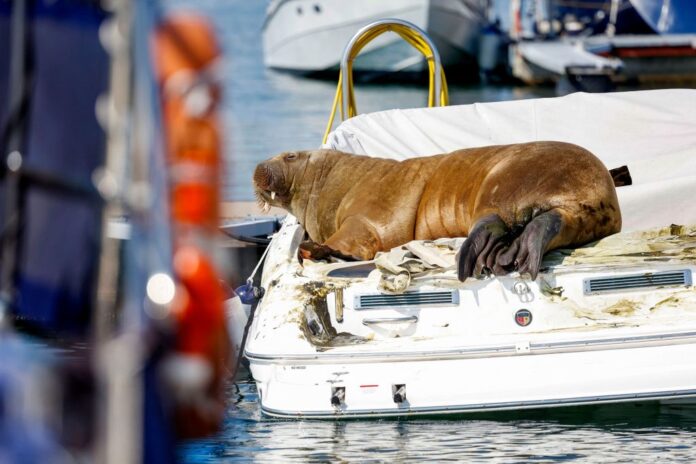Norway’s boats might be seaworthy but are they walrus-worthy? Freya is putting them to the test.
For months, the people of Norway have been captivated by an enigmatic celebrity, a 600-kilogram walrus affectionately named Freya, after the Norse goddess of love and beauty.
Clearly on an extended vacation, Freya is taking a break from the chilly Arctic Circle and holidaying in the south. Her itinerary includes stops in Norwegian harbours, sampling the local fare, dozing in the sun and, of course, crushing small boats under her bulky frame.
Freya’s perch of choice so far has been rigid inflatable boats that sit low in the water and are easy for her to clamper onto — though, an earlier video of Freya’s escapades found her on a Dutch navy vessel.
Regardless of the boat, no vessel is safe from Freya’s strict sleep schedule.
Walruses can sleep up to 20 hours a day, meaning that many of the unlucky boats Freya has chosen as nap spots have eventually sunk into the sea.
“We have been in contact with the insurance company, and they probably do not cover walrus damage,” Tuva Schøyen Grue, 20, told Norwegian broadcaster TV 2 after Freya wrecked her inflatable boat.
Kathrine Ryeng, a veterinary medicine scientist at Norway’s Institute of Marine Research, told NBC News that Freya is likely choosing to sleep, relax and digest food on empty boats because they remind her of Arctic ice floes.
Though she may be cute, Ryeng and Norwegian officials are warning the public to not get too close to her.
“These animals are like potato sacks on a floating device, but like acrobats in water,” she said.
Ryeng has been working with Norway’s Directorate of Fisheries on how to keep Freya, the public and their property safe. They advise keeping a good distance from Freya, especially in the waters around her, and parking boats so they’re harder for her to access.
No one has been injured so far by Freya or her ship-sinking habits, but that hasn’t stopped angry boat owners from wanting her gone.
The Directorate of Fisheries made a statement Tuesday saying that “euthanasia is out of the question” for Freya as walruses are a protected species in Norway, though the agency wrote that the “move to relocate may become relevant if the situation worsens.”
Freya has been in the waters around Oslo, Norway’s capital city, since July 17, The Guardian reports, but experts cited by NBC News believe she is likely from Svalbard, a Norwegian archipelago in the Arctic Circle that is around 2,000 kilometres away. That’s quite a swim!
So, why exactly did Freya travel this far?
A female walrus named Freya lies at the waterfront at Frognerstranda in Oslo on July 18, 2022.
Tor Erik Schrøder/NTB/AFP via Getty Images
Aae’s map, though, has proved useful in answering the question of why Freya travelled so far outside her home in the Arctic.“When I saw the map of the walrus’ movements, a light came on for me,” Ryeng said inan article posted by Norway’s Institute of Marine Research. “I found (the Institute of Marine Research’s) report on Pacific oysters and found a large overlap between places Freya has visited and stayed, and areas with a large abundance of Pacific oysters.“I can only say that there seems to be a clear connection here.”
Screenshot of an interactive map made by doctoral student Rune Aae, showing the locations Freya the walrus has visited in the past couple of years.
Rune Aae/Google Maps
This is important because Pacific oysters are an invasive species in the Atlantic-adjacent seas of northern Europe, where Freya is touring.Walruses love molluscs, and can chow down on as many as 3,000 to 6,000 shellfish a day. If Freya has developed a taste for the invasive species, then she proves to be an environmental service to northern European coasts.Marine researcher Lars-Johan Naustvoll, who was involved in mapping concentrations of Pacific oysters around Norway, also agrees with Ryeng’s conclusion.
Read more:
‘Stay back!’ B.C. resident films close encounter with 3 bears as mama bear charges
“The idea struck me as yes, because there are a lot of Pacific oysters in these areas,” he told the Institute of Marine Research. “Single shells are also often scattered here, which makes them more accessible to a walrus.”“If Freya actually eats this delicacy, she could prove to be a resource for management by limiting spread and clearing the population.”
© 2022 Global News, a division of Corus Entertainment Inc.



